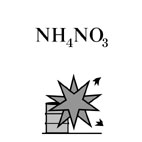| Case Name |
Explosion of ammonium nitrate caused due to superfluous concentration at an ammonium sulfate recovery process |
| Pictograph |

|
| Date |
December 22, 1952 |
| Place |
Nagoya, Aichi, Japan |
| Location |
Chemical factory |
| Overview |
In vacuum evaporation facilities that recovered ammonium sulfate from an ammonium sulfate aqueous solution obtained by a caprolactam manufacturing plant as a by-product, a large explosion occurred during usual operation. In the waste liquid after concentrated ammonium sulfate was removed, ammonium nitrate concentrated and exploded. The actual concentration was 33%. It is known that sensitive ammonium nitrate with a high explosion risk is generated around transition points of 125 °C and 84 °C. A detonation is reported to be caused with minimal energy. |
| Incident |
Explosion occurred at a caprolactam manufacturing plant in a nylon plant. Ammonium sulfate was recovered from a by-product ammonium sulfate aqueous solution including a small amount of ammonium nitrate, etc. with a vacuum evaporator. A large explosion occurred. Refer to Fig2. |
| Processing |
Manufacture |
| Individual Process |
Evaporation |
| Process Flow |
Fig3.Unit process flow
|
| Chemical Equation |
Fig4.Chemical reaction formula
|
| Substance |
Ammonium nitrate, Fig5 |
| Type of Accident |
Explosion, Fire |
| Sequence |
Small amounts of ammonium nitrate, lactam, and oxime were contained in an ammonium sulfate aqueous solution obtained from the caprolactam manufacturing process in a nylon plant as by-products. A large explosion occurred during the ammonium sulfate recovery operation from this aqueous solution at the vacuum evaporation unit. The explosion occurred at No. 2 evaporator and the underground mother liquid tank of the vacuum distillation plant. The recovery factory, a steel slate building of 230 square meters, was destroyed, and a crater with 12 m in diameter and 3 m in depth appeared near the mother liquid tank. From the destruction, the explosive power was estimated to be the same as a 2-5 tons bomb. |
| Cause |
The explosion seemed to occur by a blockage in evaporation tubes of ammonium nitrate under superfluous concentration. The following are possible causes.
1. Ammonium nitrate concentrated in the evaporator bottom liquid after ammonium sulfate recovery (actually, ammonium nitrate concentrated to 33%). It was confirmed that a blockage in evaporation tubes or outlet piping of ammonium nitrate could cause an explosion at a certain concentration and/or temperature. The blockage of the vapor pipe can be caused by an abnormality of the evaporator bottom liquid, etc.
2. According to the report; sensitive ammonium nitrate with a remarkably high explosion risk can be generated around transition points of 125 °C and 84 °C during the manufacturing process. The sensitivity might appear as a lot of air is contained inside the crystal during the crystallization process with temporal heat emission by the crystal transition, and the ammonium nitrate might detonate with minimal energy. |
| Countermeasures |
1. Ammonium nitrate should not be concentrated to over 10%.
2. A batch system was recommended to ensure this condition. Never take anything but steam from a batch.
3. So that operation is conducted under a certain temperature, pressure, capacity conditions, etc., an automatic controller should be used.
Although these countermeasures were proposed at that time, it is now recommended that an automatic analyzer is introduced with a continuous operation system to maintain fixed conditions. |
| Knowledge Comment |
It is shown that investigations and experiments considering a particle of impurities are necessary for a new process. |
| Background |
Although there was a lack of a preliminary survey, the actual cause might be unknown because details of the ammonium nitrate explosion had not been sufficiently proven at the time of the accident in 1952. However, it is possible to carry out a preliminary survey now because there are various ways of estimating the danger at present. |
| Incidental Discussion |
Although the accident occurred a long time ago in 1952, it is described in order to show the danger of ammonium nitrate. |
| Reason for Adding to DB |
Example of accident caused due to a lack of fundamental knowledge about material hazards |
| Scenario |
| Primary Scenario
|
Insufficient Analysis or Research, Insufficient Prior Research, Danger of Material, Poor Value Perception, Poor Safety Awareness, Inadequate Risk Recognition, Planning and Design, Poor Planning, Poor Process Design, Bad Event, Chemical Phenomenon, Concentration, Bad Event, Mechanical Event, Blockage, Secondary Damage, External Damage, Explosion, Bodily Harm, Death, 22 person died, Bodily Harm, Injury, 363 person injured, Damage to Society, Social Systems Failure, 142 buildings damaged
|
|
| Sources |
The Japan association of property insurance. Disaster case Fertilizer factory, Fire Prevention 1 Petrochemical Industry's Fire and Explosion Prevention Guidelines, pp.130-132(1970)
M. Tamura, M. Wakakura, Explosion of oxime ammonium sulfate under recovery operation, Reaction danger -accident case and analysis-p.144(1995)
The industrial accident case research association, Explosive and oxidizing substances, Explosion(Industrial disaster case report 1), pp.104-107(1971)
The association of chemical industries. Case of disaster at caprolactam plant. Accident disaster case and safety countermeasure. Safety countermeasure technology of chemical plant 4, pp.301-302(1979).
|
| Number of Deaths |
22 |
| Number of Injuries |
363 |
| Physical Damage |
The factory was damaged seriously, 142 houses were damaged. |
| Multimedia Files |
Fig2.Field photograph
|
|
Fig5.Chemical formula
|
| Field |
Chemicals and Plants
|
| Author |
ARAI, Mitsuru (Environmental Science Center, The University of Tokyo)
TAMURA, Masamitsu (Center for Risk Management and Safety Sciences, Yokohama National University)
|
|